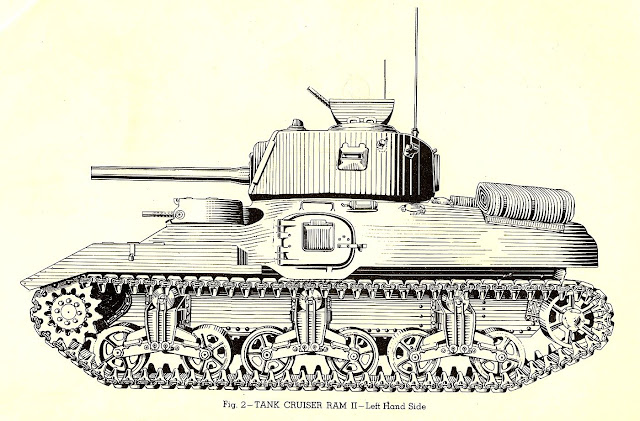Tankers!!
This time we will see some Canadian Girls who are unfortunately forgotten by the Big Manufacturers of injected kits: Ram cruiser tanks.
I'll show to you guys the three best-known armed versions of this tank: the Mk I and the early and late versions of the Mk II...
 |
| Ram mk I with 2pdr gun |
 |
| Ram Mk II early with 6pdr gun Mk III (43 caliber) |
...and the Ram Observation Post vehicle (Ram OP). This kit I will present to you guys as case report.
 |
| Ram Mk II OP in Normandy. Notice the Hessian net |
The Tank, Cruiser, Ram was a cruiser tank designed and built by Canada in the Second World War, based on the U.S. M3 Medium tank. Due to standardization on the American Sherman tank for frontline units, it was used exclusively for training purposes and was never used in combat as a gun tank. The chassis was used for several other combat roles however, such as a flamethrower tank, observation post, and armoured personnel carrier.
Development:
Even before the loss of the majority of the United Kingdom's tank force in France in 1940 after Dunkirk, it was recognised that tank production in the UK at the start of the war was insufficient and capacity in the US was taken for British needs. So it was necessary that if Canada was to equip with tanks they would have to be manufactured locally. In June 1940 the Canadian Pacific Railway's Angus Shops in Montreal - as the only large firm with spare capacity - had received a contract to produce 300 partially fitted out Valentine tanks for the British; this was followed later with one for 488 complete tanks for Canada.
However the Valentine was an infantry tank and Canada required a cruiser tank for its recently formed armoured division. In the end 1,940 Valentines were produced by CPR most of which were supplied to the USSR. Although the Valentine used a number of American produced parts, its reliance on British components, difficulties in adapting its manufacture to North American methods, and other problems such as limitations to the availability of the right type of armour plate affected Valentine production. The Canadian Joint Committee on Tank Development concluded, in September 1940, that its cruiser tank should be based on a US rather than a British design.
However the Valentine was an infantry tank and Canada required a cruiser tank for its recently formed armoured division. In the end 1,940 Valentines were produced by CPR most of which were supplied to the USSR. Although the Valentine used a number of American produced parts, its reliance on British components, difficulties in adapting its manufacture to North American methods, and other problems such as limitations to the availability of the right type of armour plate affected Valentine production. The Canadian Joint Committee on Tank Development concluded, in September 1940, that its cruiser tank should be based on a US rather than a British design.
The Canadians were interested in production of the M3 Medium. However the M3 was an interim design and lacked a turret for its main armament. In early 1941 the Canadian Interdepartmental Tank Committee adopted a compromise: to develop a superior design locally but using the M3 chassis. The British Tank Mission which was involved in the modifications of the M3 for British use contributed a tank expert - L.E.Carr - to design a new hull and turret for the Canadian tank, which could take a 6-pounder (57 mm) or 75mm gun while retaining the lower hull of the US M3 Medium.
 |
| The Ram upper cast hull - left side |
 |
| Ram upper cast hull - right side |
 |
| Ram prototype |
Canadian engineers ran into many challenges when developing the tank as Canada had never produced a tank before. Along with the lack of knowledge, it took time for Canadian factories to gear up for the production of many of the Ram's components. Initially Canada relied heavily on United States and British materials to complete the construction of the Ram. Most critically the Ram's Continental engine and transmissions were available only in the USA and these were always in short supply. The Ram tank was developed with a turret which unlike the US M3 could traverse the main armament 360 degrees.
Its fully cast armoured steel hull gave reinforced protection and - with the driver's seat repositioned to meet British requirements for right-hand drive - lower height while the US designed chassis and power train ensured its overall reliability.
 |
| Turrets under final construction |
Although it could mount a US 75 mm gun, the preferred armament for the Ram was the QF 6 pounder which had superior armour-piercing capability. As it was not immediately available, early production (50 tanks) were fitted with the 40 mm 2-pounder gun.
A prototype Ram was completed in June 1941 and general production of the Ram I began in November of the same year. The Ram I and early Ram IIs were fitted with side doors in the hull and an auxiliary machine gun turret in the front.
The former weakened the hull and complicated production and the doors and the machine gun turret would be discarded in later modifications. By February 1942, production had switched to the Ram II model with a 6-pounder gun and continued until July 1943.
In March 1942 a decision had been made to change production over to the automotively-similar M4A1 Grizzly cruiser tank, the Canadian built Sherman - for all British and Canadian units. Ram production continued due to delay in starting the new M4 production lines and a reluctance to let the plant lie idle. By July 1943 1,948 vehicles, plus 84 artillery observation post (OP) vehicles, had been completed.
 |
| Ram Mk I with 2pdr. gun |
 |
| Ram Mk II early with 6pdr gun Mk III (43 caliber) |
 |
| Ram Mk II early with 6pdr gun Mk III (43 caliber) Notice the absence of hull's hatch |
 |
| Ram Mk II early with 6pdr gun Mk III (43 caliber) Notice the absence of hull's hatch and gun's counterweight... |
 |
| Ram Mk II late with 6pdr gun Mk V (50 caliber) |
 |
| Grizzly Cruiser tank - an M4A1 built in Canada |
The official Canadian history of the war compares the Ram to the Ross rifle as examples of unsuccessful Canadian weapon designs. It states that given the Sherman's superiority, in retrospect it would probably have been better for the United States to produce more tanks, and for Canada to have focused on manufacturing more transport vehicles such as the successful Canadian Military Pattern truck designs. The Sexton Mk I self-propelled gun based on the Ram chassis, however, was very successful.
 |
| Sexton Mk I based in Ram chassis |
Combat history:
As built, the Ram was never used in combat as a tank, but for crew training in Great Britain up to mid 1944.
The Ram Observation Post vehicles (Ram OP), flamethrower (Ram Badger), armoured Personnel Carrier (Ram Kangaroo) , Gun armored tower, and armoured ammunition carrier of the Ram saw considerable active service in North West Europe.
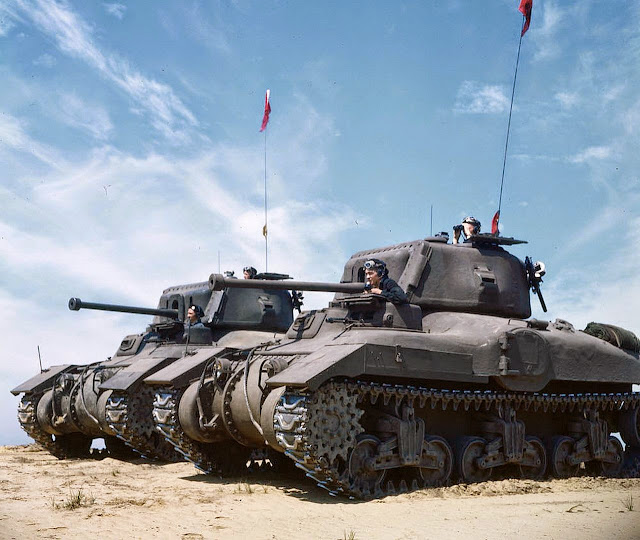 |
| Rams Mk II early with 6pdr gun Mk V/50 in training in England |
 |
| Ram Mk.II early on Diamond T 980 and Rogers 40-ton trailer 65th Tank Transporter Coy, RCASC, in trials. England, 1944. |
 |
| The same Ram Mk.II above. Notice the side hull without hatches or ventilators... |
 |
| Ram Mk.II in landing trials, with full load in his rear deck... Notice the late bogies, but with 43 caliber 6 pdr. gun |
The photo below shows a Ram OP tank somewhere in Normandy; It was a Ram II which had a dummy gun in place on the exterior, and two No. 19 Wireless sets inside. These tanks accompanied the Sexton S.P. gun regiments as mobile observation posts for their FOOs, who up until this time had a fairly high attrition rate when travelling on foot or by carrier with the infantry. Notice the VVSS heavy duty suspension and the fake gun:
 |
| Ram OP after landing in Normandy |
 |
| Ram Badger flamethrower |
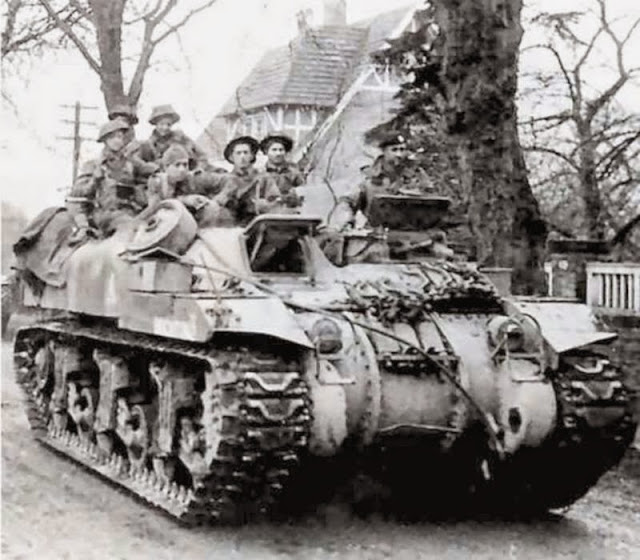 |
| Ram Kangaroo early - notice the MG turret |
 |
| Ram Kangaroo late - notice the MG in the front hull |
 |
| Ram armoured gun tower towing the 17pdr anti-tank, gun and ammunition limber. |
 |
| Ram armoured gun tower rear view - Notice the the rear towing hook. |
 |
| Ram armoured ammunition carrier issued to 1st Canadian Armoured Personnel Carrier Regiment, font: MilArt |
In 1945 the Royal Netherlands Army got permission from the Canadian government to take possession for free of all Ram tanks in army dumps on Dutch territory. Those not already converted into Kangaroos were used to equip the 1st and 2nd Tank Battalion (1e en 2e Bataljon Vechtwagens), the very first Dutch tank units. These had a nominal organic strength of 53 each. However it proved to be impossible to ready enough tanks to attain this strength because the vehicles were in a very poor state of maintenance. In 1947 the UK provided 44 Ram tanks from its stocks, that were in a better condition. Forty of these had been rebuilt with the British 75 mm gun; four were OP/Command vehicles with a dummy gun. This brought the operational total for that year to just 73, including two Mark Is. In 1950 only fifty of these were listed as present. The Ram tanks (together with the Sherman tanks of the three other tank battalions, in part simply taken without permission) were replaced by Centurion tanks leased by the U.S. Government in 1952. Some Ram tanks were used in the 1950s as static pillboxes in the IJssel Line, their hulls dug in and embedded within two feet of concrete.
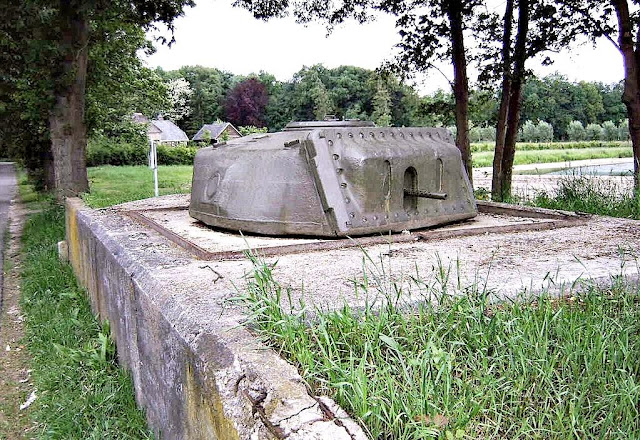 |
| Ram tank embedded in concrete in Holland |
Variants:
- Ram Mk I Tank Cruiser: Ordnance QF 2 pounder / 40mm gun (171 rounds).
- Ram Mk II Tank Cruiser:
- Early production: Mk III QF 6 pounder / 57mm gun (92 rounds).
- Late production: Mk V six-pounder. Auxiliary turret and sponson door removed. Browning .303 in (7.7 mm) machine gun fitted in ball mount.
- Ram Badger: A flamethrower equipped tank. The first Badgers were Ram Kangaroos with the Wasp II flamethrowing equipment (as used on the Universal Carrier) installed in place of the bow MG. Later models were turret rams with the equipment in place of the main gun.
- Ram Kangaroo: An armoured personnel carrier for 11 men plus 2 crew. See Kangaroo.
- Ram OP/Command (84): An armoured vehicle to function as a mobile observation posts for the Forward Observation Officers (FOO) of Sexton self-propelled gun units, based on Ram Mk II. The gun was replaced by a dummy, and two Wireless Set No. 19 radios were fitted with a No. 58 set. Crew of 6. They were built from the last 84 Rams off the production line in 1943.
- Ram GPO: Like OP but with special equipment for gun position officers of SP artillery regiments. Had Tannoy loudspeakers mounted.
- Sexton 25-pdr, SP, Tracked: Self-propelled artillery vehicle armed with QF 25 pounder gun in open-topped superstructure.
- Ram Wallaby: Armoured ammunition supply vehicle, carried 25 pdr ammunition for Sexton.
- Ram ARV Mk I: Armoured recovery vehicle based on Ram Mk I. Winch added.
- Ram ARV Mk II: ARV based on Ram Mk II. Jib and earth spade added, turret replaced by dummy.
- Ram Gun Tower: Armoured artillery tractor for use with Ordnance QF 17 pounder towed Anti-tank gun.
- Ram BARV: (Beach Armoured Recovery Vehicle) - one prototype built.
Survivors:
- One Dutch Ram tank, an OP/Command vehicle, survives at the Dutch Cavalry Museum in Amersfoort.
- A Ram tank modified as a Kangaroo serves as a memorial to the 1st Canadian Armoured Carrier Regiment in Mill, Netherlands.
- Ram tanks can also be seen at the Canadian War Museum, in Worthington Park at Canadian Forces Base Borden, in front of the Beatty Street Armoury in Vancouver, and at the Bovington Tank Museum (both a tank and a Kangaroo)
| Ram Cruiser Tank (Mk I & II) and Ram OP | |
|---|---|
Type
| Medium tank |
Place of origin
| Canada |
| Service history | |
Used by
| Canada |
Wars
| Second World War |
| Production history | |
Designed
| 1941 |
Manufacturer
| Montreal Locomotive Works |
Produced
| 1941–43 |
Number built
| approx 2,000 |
| Specifications | |
Weight
| Mk I: 28 t - Mk II:29 t - OP: 27 t |
Length
| 5.8 m |
Width
| 2.9 m |
Height
| 2.67 m |
Crew
| 5 (Commander, gunner, loader, driver, co-driver/hull gunner) |
Armour
| 25-87 mm |
Main armament
| Mk I - 2pdr Gun Mk IX - 171 rds MkII early - QF 6 pdr Mk III with 43 caliber - 92 rds Mk II late - QF 6pdr Mk V with 50 caliber - 92 rds OP- none |
Secon. armament
| Mk I: 3 × .30 in (7.62 mm) Browning Mk I: 4,715 rounds MkII: same with 4,440 rounds OP: .30 in (7.62 mm) Browning - 3.000 rounds |
Engine
| Continental R-975 9-cyl radial gasoline engine 400 (298 kW) |
Power/weight
| 12.3 hp/ton |
Transmission
| Borg-Warner clutch, controlled differential |
Suspension
| Vertical volute spring |
Op. range
| 232 km |
Speed
| 40 km/h |
The kits:
Well...this is a long history... Years, many years ago I bought a Ram tank from S-Models, a resin kit.
At that time, it was the only option to build a Ram. Well: I decided to make molds silicone and merge some hulls and turrets. Good times with the smell of the polyurethane eroding your lungs ...
The years was passed and I forgot those things in an old box in the back of my closet ... One day, I bought a Ram OP from Formations, build the kit and loved the experience. I wrote to the Formations and bought another, in order to try to turn the OP version in a version with gun. But once again, the thing was forgotten because of more new and interesting projects...Until now !!!
That's what I found when I opened a box entitled "Ram Project":
 |
| Three-dimensional translation of madness !!!! |
- As I don't have Ram gun tanks in my collection...
- As I have a lot of scrap parts available...
- As I have time (I'm on vacation)...
- and modeling for me is fun, not religion,..
- I'll try to turn this bunch of resin parts into 3 tanks that may not be accurate for purist eyes, but I'll enjoy myself enough. I guarantee that !!!
Some scandalous parts in resin:
 |
| This is Sparta !!!! |
 |
| The hull, turret and tranny are copies...Metal gun from RBModels |
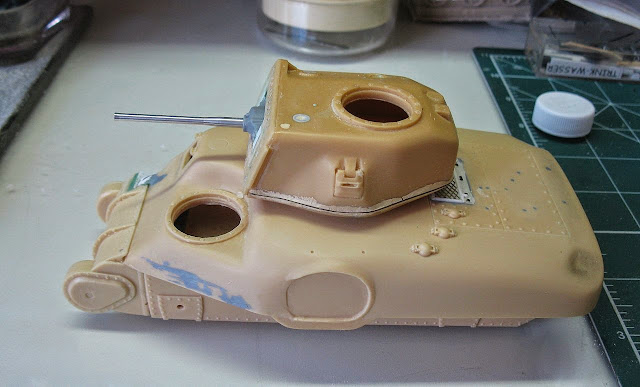 |
| Side view. The details in the turret's pistol ports has deteriorated... |
 |
| Rear view. Notice the rear panel of chassis: Dragon spare part |
 |
| Dimensional comparison between the hulls: The upper hull from S-Models are too wide and too short |
 |
| ... but the difference is not that big. |
 |
| Los 3 amigos |!!! |
 |
| Surgery time: Dremel, dental drill and old Tamiya part |
 |
| Surgery done...Now, it's time to glue the new pistol port with cyanoacrylate... |
 |
| The Rams in production line... Notice the absence of horseshoe in the late mantlet |
 |
| MkI, Mk II early and Mk II late (left from right) Metal guns are RBModels and AFV spare part (Churchill) |
 |
| Brownings for the girls !!! |
And the Canadian Girls, growing and growing...
 |
| Ram Mk I - 90% ready... |
 |
| Notice the absence of fenders, characteristic of the first units ... |
 |
| Ram Mk II early - almost there ...85% |
 |
| Notice the holes for the 4 pairs of footman's loops welded directly to the hull in the rear deck |
 |
| Ram Mk II late - with shoes, by Jove !!! Almost 95% ready... |
But now, the true horror: Tracks WE-210 from Bronco (#AB3543), LBL, for the Mk I early. The kit of tracks is very well done, but are thousands of little parts glued on each other, like a real nightmare. But the Ram Mk I used this tracks and the pain is beginning...
 |
| Like a big toothache !!! |
I already told to you: I hate LBL tracks!
Devil's invention!!!
After a week in this tracks... |
| Definitely, I hate tracks LBL !!!! |
I finally managed to finish the kits: First of all, the Mk I:
 |
| Notice the absence of the fenders and in the headlights in brackets over the tracks. Something common with the early models, like the picture below: |
The Mk II early:
and the Mk II late:
When we put the tanks together, we noticed the discrepancies between the models S-Models and Formations.
Next step: markings. As usual, I tried to do drawings just like references for decal's application:- For Mk I, I choose a vehicle from the 5th Canadian Armoured Division:
- For Mk II early, a tank from 1st Canadian Armoured Brigade
- And for the Mk II late, a tank from 2nd Canadian Army Tank Brigade
Panzerserra decals:
And the Canadian girls with make-up. Now, they will rest for a night, for the decals adhere perfectly with the Future ...
And only now I noticed that I forgot to change the wheels from Tamiya suspensions. The Lees and Grants Tamiya comes with wheel bogie with six spokes and holes, which is a mistake. And my kits deserve at least a little more care... Can be built with old parts, but not so wrong ... Surgery time: cut the old wrong wheels from bogies arms:
And the girls with right shoes and starting the weathering...First of all, the Mk I:
And the Canadian girls with make-up. Now, they will rest for a night, for the decals adhere perfectly with the Future ...
 |
| Notice the glossy aspect: Future. |
 |
| Notice the arms without the wheels... |
Now, it's time to paint and built the tools and stowage in the girls...The end is near !!! But, before that, I'll post here the building of Ram OP, that I built in 2004. The kit is from Formations:
 |
| The Formation parts...excelent !!! |
 |
| The suspension for Ram OP |
 |
| Drive sprockets from Italery (spare parts) |
 |
| The dummie gun |
 |
| primer |
The markings are 4th CAD, RCA, 23rd FR.
 |
| Artillery Observation Post !!! |
 |
| Tools in resin...awesome |
Well, tankers...The final pics... Let's go, Canada !!!!
Ram Mk I from 5th Canadian Armoured Division, Lord Strathcona's Horse, in England, 1942.
 |
| Ram Mk I from 5th Canadian Armoured Division, Lord Strathcona's Horse |
 |
| Ram Mk I from 5th Canadian Armoured Division, Lord Strathcona's Horse left side |
 |
| Ram Mk I from 5th Canadian Armoured Division, Lord Strathcona's Horse right side |
 |
| Ram Mk I from 5th Canadian Armoured Division, Lord Strathcona's Horse with Kojak and Rover, the dog. |
Now, the Ram Mk II (early) from 1st Canadian Armoured Brigade, Three Rivers Regiment, in training duties. England, 1943.
 |
| Ram Mk II (early) from 1st Canadian Armoured Brigade Three Rivers Regiment |
 |
| Ram Mk II (early) from 1st Canadian Armoured Brigade, Three Rivers Regiment right side |
 |
| Ram Mk II (early) from 1st Canadian Armoured Brigade Three Rivers Regiment left side |
 |
| Ram Mk II (early) from 1st Canadian Armoured Brigade Three Rivers Regiment with Kojak and Rover, the dog. |
 |
| Ram Mk I and Ram Mk II early |
Ram Mk II (late) from 2nd Canadian Army Tank Brigade, Sherbrooke Fusiliers, England, 1943.
 |
| Ram Mk II (late) from 2nd Canadian Army Tank Brigade, Sherbrooke Fusiliers England, 1943 |
 |
| Ram Mk II (late) from 2nd Canadian Army Tank Brigade Sherbrooke Fusiliers right side |
 |
| Ram Mk II (late) from 2nd Canadian Army Tank Brigade Sherbrooke Fusiliers left side |
 |
| Ram Mk II (late) from 2nd Canadian Army Tank Brigade Sherbrooke Fusiliers with Kojak and Rover, the dog |
 |
| Ram Mk I, Ram Mk II early and Ram Mk II late cruiser tanks |
And finally, the Ram Mk II (late) OP from 4th Canadian Armoured Division, Royal Canadian Artillery, 23rd Field Regiment, attached as Command Post of Sextoxs Batteries in Netherlands, 1944.
 |
| Ram Mk II (late) OP from 4th Canadian Armoured Division Royal Canadian Artillery, 23rd Field Regiment - Netherlands, 1944. |
 |
| Ram Mk II (late) OP from 4th Canadian Armoured Division Royal Canadian Artillery, 23rd Field Regiment - right side |
 |
| Ram Mk II (late) OP from 4th Canadian Armoured Division Royal Canadian Artillery, 23rd Field Regiment notice the telephone cables in the rear deck... |
 |
| Ram Mk II (late) OP from 4th Canadian Armoured Division Royal Canadian Artillery, 23rd Field Regiment - left side |
 |
| Ram Mk II (late) OP from 4th Canadian Armoured Division Royal Canadian Artillery, 23rd Field Regiment the gun is fake and the turret was bolted. |
 |
| Ram Mk II (late) OP from 4th Canadian Armoured Division Royal Canadian Artillery, 23rd Field Regiment with Kojak and Rover, the dog. |
 |
| Ram Mk I, Mk II early, Mk II late and Mk II OP. |
Well, lads ... I know the S-Models kits are dimensionally questionable, but the discrepancies are not that big. And while there is nothing better on the market, the Armoured Forces of Canada are well represented in my collection.
See you soon, Boys !!!









